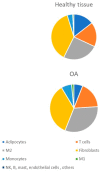Phenotype Diversity of Macrophages in Osteoarthritis: Implications for Development of Macrophage Modulating Therapies
- PMID: 35955514
- PMCID: PMC9369350
- DOI: 10.3390/ijms23158381
Phenotype Diversity of Macrophages in Osteoarthritis: Implications for Development of Macrophage Modulating Therapies
Abstract
Chronic inflammation is implicated in numerous human pathologies. In particular, low-grade inflammation is currently recognized as an important mechanism of osteoarthritis (OA), at least in some patients. Among the signs of the inflammatory process are elevated macrophage numbers detected in the OA synovium compared to healthy controls. High macrophage counts also correlate with clinical symptoms of the disease. Macrophages are central players in the development of chronic inflammation, pain, cartilage destruction, and bone remodeling. However, macrophages are also involved in tissue repair and remodeling, including cartilage. Therefore, reduction of macrophage content in the joints correlates with deleterious effects in OA models. Macrophage population is heterogeneous and dynamic, with phenotype transitions being induced by a variety of stimuli. In order to effectively use the macrophage inflammatory circuit for treatment of OA, it is important to understand macrophage heterogeneity and interactions with surrounding cells and tissues in the joint. In this review, we discuss functional phenotypes of macrophages and specific targeting approaches relevant for OA treatment development.
Keywords: inflammation; macrophages; osteoarthritis.
Conflict of interest statement
The authors declare no conflict of interest.
Figures
References
Publication types
MeSH terms
Grants and funding
LinkOut - more resources
Full Text Sources
Medical


